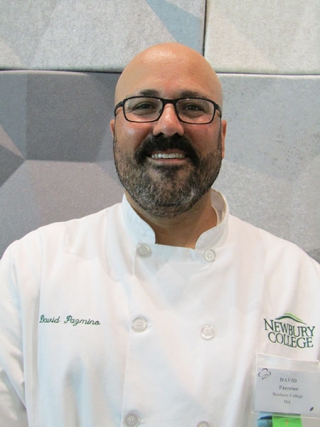
The Art of the Mini-Lecture
30 November 2018Creating mini-lectures or stories that relate a lesson’s hows and whys captivates students, helps them retain facts, and develops soft skills.
By Chef David Pazmiño of Newbury College
The culinary industry is a fast-paced, ever-changing industry. Yet despite all these changes, a set of soft skills such as communication and organization are at the core of most culinary training. And of those soft skills, the skill of following instructions is particularly important. Yet unlike the simple game of Monkey-See-Monkey-Do, often these instructions are multifaceted, complex, and involve a certain degree of critical analysis to execute properly. Unfortunately, attaining these skills is not innate, but rather learned. Sure, there are students that will process and recall information faster than others, but at the beginning they all start off in the same place.
Chefs have often found ways to handle this over the years. Many of us have seen or used small notebooks or index cards for students to write down instructions, recipes, and formulas of all types. I am sure we have also all played around with prep lists for students to follow. In some cases, this works great and in other cases the notebooks are lost, dropped in liquids, or left in the classroom never to be reclaimed. While a part of me feels that if students aren’t invested in their education, why should I bother with a process that they never keep up? But, keeping a growth mindset mentality, it really means me saying, “They may not be there, yet.”
I also have toyed with having students write these notes on their phones instead of physically writing them down. But, granting more access to mobile devices in the kitchen has the potential to create other problems rather than solving the problems I am addressing.
One afternoon during office hours, the hallway outside my office was filled with students waiting for advising. I overheard students quizzing each other about content for their Bakeshop I upcoming final practical and exam. One student asked the other, “Don’t you remember the story about the two sisters?” She was referencing a story I told while explaining the role of gluten in biscuits versus scones. Over the years, I have developed stories to link scientific food concepts with their practical application. I was teaching the students about how the protein precursors in flour, gliadin and glutenin, form gluten while they are making flaky biscuits. The story refers to Gliadin and Glutenin as two sisters that while they are not the best of friends they become increasingly bonded when they become wet. The principle of gluten development is reinforced by linking a scientific principle with the practical application of making biscuits. Through the subsequent folding of the biscuit dough to punch out more biscuits, the gluten is further developed, making biscuits that are increasingly tougher and less flaky. When I have the students taste the difference between the various biscuits, I have them go back and relate the story about forming gluten from gliadin and glutenin.
Storytelling has a profound impact on memory. As humans, we are often captivated by stories more often than trying to remember raw facts. I have integrated stories into what I call “mini-lectures” throughout the years. Many of the classes I teach have different stations two to three students rotate through during the course. I then pre-set several three- to five-minute lectures for each station that intertwine a scientific principle, such as a mixing method, or a cooking technique, along with a story. I then go back and reinforce these principles through the homework they complete or the assessments they take.
For some of my mini-lectures, I find pieces of parchment paper either left whole or cut in half work as a great a mobile writing surface. I have even designated one of the students in the mini-lecture to keep the notes. Students then often take pictures of either the group notes or my notes on the subject.
One of the best parts of these mini-lectures is that it feels intimate. Having two or three students gathered around to hear information keeps them focused and attentive for those brief minutes. It also may be less intimidating for them to ask questions. Creating a canned story or allegory that exemplifies what they are doing - with both the hows and whys of the lesson - helps give students the confidence to think about what they are cooking and not merely following a recipe or formula. And it is this confidence that translates into those hard to teach soft skills: organization and communication.
